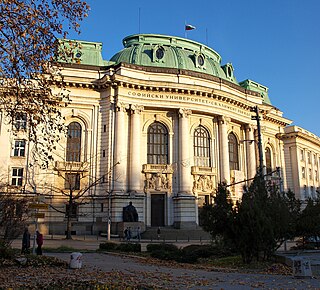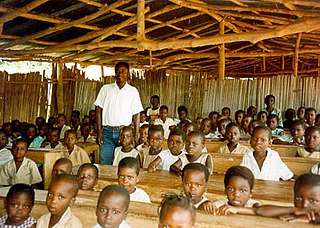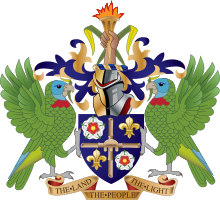The education in Suriname was initially set up in analogy to the Dutch education system. In terms of structure, the education system is now a mixture of school types that were common in the Netherlands before, during and after the Mammoetwet. The language of instruction is Dutch; mainly Surinamese Dutch. The four exceptions to this rule are the International Academy of Suriname, administered by a local Christian foundation, Christian Liberty Academy, administered by the Caribbean Christian Ministries, and the AlphaMax Academy, a private nonsectarian school administered by the AlphaMax Foundation, and since 2011 Suriname International School, which provides k12 online school for high school students.

Education in Bulgaria is guided and overseen by Bulgarian Ministry of Education and Science. Compulsory education includes three years of pre-primary education, primary education, and secondary education. Education is compulsory until age of 16. Compulsory education at state schools is free of charge. The state and private higher education schools, colleges and universities charge fees, although they offer students scholarships.
Education in Costa Rica is divided in 3 cycles: pre-education, primary education, and secondary school, which leads to higher education. School year starts between the second and third week of February, stops at the last week of June, it continues again between the third and fourth week of July and finishes between the last week of November and the second week of December. Preschool and basic education are free to the public. Elementary and secondary school are both divided in two cycles. Since 1869, education is free and compulsory.

Education in Montenegro is regulated by the Ministry of Education and Science of Government of Montenegro.
Education in Belarus is free at all levels except for higher education. The government ministry that oversees the running of the school systems is the Ministry of Education of the Republic of Belarus. Each of the regions inside Belarus has oversight of the education system, and students may attend either a public (state) or a private school. The current structure of the educational system was established by decree in 1994. The education system is also based on The Education Code of the Republic of Belarus and other educational standards.
Education in Nicaragua is free for all Nicaraguans. Elementary education is free and compulsory although this is not strictly enforced. Many children are not able to attend if their families need to have them work. Communities on the Atlantic Coast have access to education in both Spanish and the languages of the native indigenous tribes that live in the more rural areas of Nicaragua. Higher education has financial, organic and administrative autonomy, according to the law. Freedom of subjects is recognized. The school year runs from February through November.

Practically all children attend Quranic school for two or three years, starting around age five; there they learn the rudiments of the Islamic faith and some classical Arabic. When rural children attend these schools, they sometimes move away from home and help the teacher work his land.
Education in Kyrgyzstan is compulsory for nine years, between ages seven and 15. Following four years of primary and five years of lower secondary school, the system offers two years of upper secondary school, specialized secondary school, or vocational/technical school.

Western-style education was introduced to Bhutan during the reign of Ugyen Wangchuck (1907–26). Until the 1950s, the only formal education available to Bhutanese students, except for private schools in Ha and Bumthang, was through Buddhist monasteries. In the 1950s, several private secular schools were established without government support, and several others were established in major district towns with government backing. By the late 1950s, there were twenty-nine government and thirty private primary schools, but only about 2,500 children were enrolled. Secondary education was available only in India. Eventually, the private schools were taken under government supervision to raise the quality of education provided. Although some primary schools in remote areas had to be closed because of low attendance, the most significant modern developments in education came during the period of the First Development Plan (1961–66), when some 108 schools were operating and 15,000 students were enrolled.
Education in Honduras is essential to the country of Honduras, for the maintenance, cultivation, and spread of culture and its benefits in Honduran society without discriminating against any particular group. The national education is secular and founded on the essential principles of democracy, inculcating and fomenting strong nationalist sentiments in the students and tying them directly to the economic and social development of the nation. Honduras's 1982 Constitution guarantees the right to education, a right also conveyed through the National Constituent Assembly's Decree 131 and in the official daily publication La Gaceta.
Education in Saint Vincent and the Grenadines is neither compulsory nor free, although children are usually in school until the age of 15. In 1998, the gross primary enrollment rate was 90.5 percent, and the net primary enrollment rate was 83.5 percent.
Education in Georgia is free of charge and compulsory from the age of 6 until 17-18 years. In 1996, the gross primary enrollment rate was 88.2 percent, and the net primary enrollment rate was 87 percent; 48.8 percent are girls and 51.8 percent are boys. Constitution mandates that education is free. Related expenses that include textbooks and laptops are provided by the state free of charge; in 2001 there were 47,837 children not attending primary school.

Benin has abolished school fees and is carrying out the recommendations of its 2007 Educational Forum. In 2018, the net primary enrollment rate was 97 percent. Gross enrollment rate in secondary education has greatly increased in the last two decades, from 21.8 percent in 2000 to 59 percent in 2016, 67.1 percent in the case of males and 50.7 percent for females. Because of a rapid increase in the enrollment rate, the student/teacher ratio rose from 36:1 in 1990 to 53:1 in 1997 but has dropped again in the last years to 39:1 (2018). In 2018, the gross enrollment ratio in tertiary education was 12.5%.

Public education in the Central African Republic is free, and education is compulsory from ages 6 to 14. AIDS-related deaths have taken a heavy toll on teachers, contributing to the closure of more than 100 primary schools between 1996 and 1998.

Primary education in Guinea is compulsory for 6 years. In 1997, the gross primary enrolment rate was 54.4 percent and the net primary enrolment rate was 41.8 percent. Public education in Guinea is governed by three ministries: The Ministry for Pre-University Education and Literacy; The Ministry for Technical Education and Occupational Training; and the Ministry for Higher Education, Scientific Research and Innovation.
Education in Lesotho has undergone reforms in recent years, meaning that primary education is now free, universal, and compulsory.
Education in Eswatini includes pre-school, primary, secondary and high schools, for general education and training (GET), and universities and colleges at tertiary level.
Primary school education in Fiji is compulsory, and subsidised for eight years. In 1998, the gross primary enrollment ratio was 110.5 percent, and the net primary enrollment rate was 99.4 percent. As of 2001, attendance was decreasing due to security concerns and the burden of school fees, often due to the cost of transport. In 2013, the Bainimarama government made education at the primary and secondary level in Fiji free for all students. Fiji has since achieved universal access to primary education.
Education in Kiribati is free and compulsory from age 6 to 14, which includes primary school through grade six, and Junior Secondary School for three additional grade levels. In 1998, the gross primary enrollment rate was 84.4 percent, and net primary enrollment rate was 70.7 percent. School quality and access to education are better in urban areas; schools in small communities on isolated islands are expensive to maintain. Mission schools are slowly being absorbed into the government primary school system.
Education in Tonga is compulsory for children through the end of high school. In 1995, the gross primary enrolment rate was 122.2 percent, and the net primary enrolment rate was 95.3 percent. Primary school attendance rates were unavailable for Tonga as of 2001. While enrolment rates indicate a level of commitment to education, they do not always reflect children's participation in school. 98.5% of students in Tonga attend schools while the other 2% are either living in remote areas without certain schools, such as in the Niua group, or they do not have enough funds to pay for their enrolment. There are about twenty institutions for higher education, 22 high schools, and around 95 primary schools including pre-schools in different villages around Tonga.









